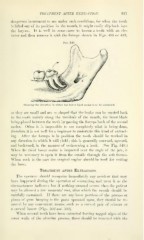Page 613 - My FlipBook
P. 613
TREATMENT AFTER EXTRACTION. Gil
dano-erous instrument to use under such conditions, for when the tootli
is lifted out of its position in the mouth, it mioht easily slip back into
the larvnx. It is well in some oases to loosen a tooth Avith an ele-
vator and then remove it with the foreejis shown in Fiirs. 488 or 489,
Fig. 549.
Showing the direction in which the lower third molar is to be extracted.
as they are small and are so shaped that the beaks can be carried back
to the tooth mainly along the vestibule of the mouth, the inner blade
beins: placed between the teeth by passing the forceps back of the second
molar. Often it is impossible to see completely what is being done,
therefore it is not well for a beginner to undertake this kind of extract-
ing. After the force])s is in })osition the tooth should be worked in
any direction in which it will yield ; this is generally outward, upward,
and backward, in the manner of unfastening a hook. (See Fig. 549.)
When the third lower molar is impacted near the angle of the jaw, it
may be necessary to open it from the outside through the soft tissues.
When such is the case the surgical engine should be used for cutting
the bone.
Treatment after Extraction.
The operator should recognize immediately any accident that may
have happened during the operation of extraction, and ti'oat it as the
circum.stances indicate ; l)ut if nothing unusual occurs, then the patient
may be allowed a few moments' rest, after which the mouth should be
carefully examined. If there are any loose portions of the process or
pieces of gum hanging to the parts operated ui)on, they should be re-
moved by any convenient means, such as a curved pair of scLssors or
a curved lancet (Figs. 502 and 504).
When several teeth have been extracted leaving ragged edges of the
outer walls of the alveolar process, these should be removed with the


